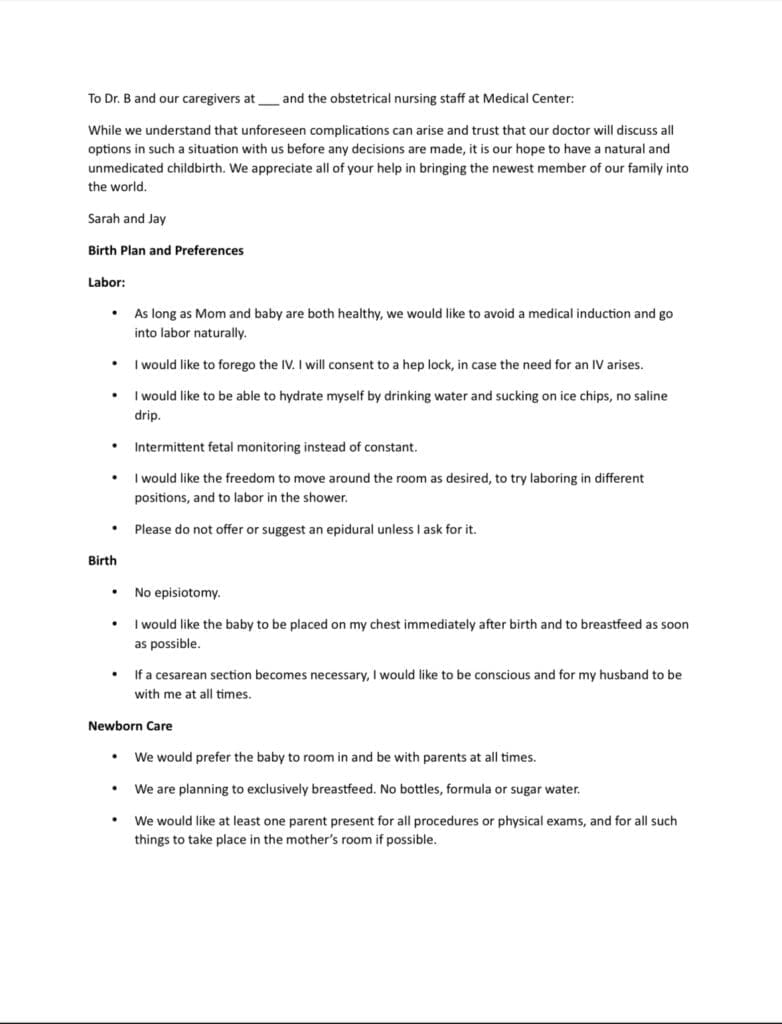The short answer? Yes.
But maybe not for the reasons you think.
A birth plan isn’t about scripting your labor down to the minute. It’s not about being “rigid” or expecting everything to go exactly as written. Instead, a birth plan is a tool. It’s a foundation for your birth experience. A birth plan helps you prepare, understand your options, and advocate for yourself throughout your birth.
When I think back on my own births and the ones I’ve witnessed, the plan didn’t always unfold as expected. But the process of creating a birth plan—of sitting down and thinking through what mattered most—made all the difference. It gave me a voice, even when things didn’t go as planned.

Why a Birth Plan Matters
It helps you explore your options.
There are so many choices in birth. Some you may not even realize you’ll be asked about until you’re in labor. Do you want continuous monitoring, or the freedom to move around? Do you want immediate skin-to-skin after birth? How do you feel about pain relief, delayed cord clamping, or newborn procedures?
Writing a plan encourages you to think through those details now, so you’re not making every decision in the middle of contractions.
It clarifies your preferences.
A birth plan helps you put your thoughts into words. Just the process of creating your plan helps you think through options and possibilities and get clarity on what you really want.
It opens conversation with your providers.
One of the most valuable parts of creating a birth plan isn’t the plan itself—it’s the conversations it starts. Sometimes we assume our providers “just know” what we want, but that may not be the case. Sharing your preferences ahead of time builds trust and ensures you’re on the same page with your OB, midwife, doula, or nurses.
It empowers you to advocate for yourself.
Birth can be overwhelming, and it’s not always easy to find your words in the moment. Having your wishes written down gives your support team a way to speak up for you if you’re too focused inward—or too tired—to do it yourself.
When My Birth Plan Wasn’t Taken Seriously

I’ll never forget the first time I brought my birth plan into the doctor’s office. It was my third pregnancy and I had spent a lot of time educating myself between births. The nurse actually rolled her eyes at me. I could have gotten an attitude back with her, but I took a deep breath and stood up for myself.
That was the first of many conversations.
Having that plan in writing opened the door for communication. It showed them I wasn’t just being overly idealistic. I had thought through my preferences carefully, and I was ready to stand up and advocate for myself.
Over time, those conversations built trust. My provider began to see me not as a patient who would be “difficult,” but as someone who had put real thought into her care.
I’ve also seen the other side: moms who walk in already on the defensive, expecting pushback, and starting out belligerent and angry. Unfortunately, that almost always shuts down communication and makes providers less willing to hear them out.
The balance, I’ve learned, is knowing what matters to you and being confident in voicing it, but doing so with respect. A birth plan helps you find that balance.
What to Include in a Birth Plan
Think of your plan as a one-page snapshot of your preferences, not a ten-page manifesto. Some things you might include:
- Environment: Do you want dim lights, music, or certain comfort measures?
- Mobility: Would you like the option to walk, use the shower, or try different labor positions?
- Pain management: What are your preferences—epidural, IV meds, nitrous, or natural comfort measures first?
- Monitoring: Continuous, intermittent, or wireless if available?
- Pushing & delivery: Preferences for positions, coached vs. uncoached pushing, delayed cord clamping.
- Newborn care: Immediate skin-to-skin, breastfeeding initiation, routine procedures (vitamin K, eye ointment, Hep B).
- Cesarean “what ifs”: Who you want present, desire for skin-to-skin in the OR, delayed cord clamping if possible.
💡 Did You Know?
Many hospital “standard procedures” are actually optional. You always have the right to give—or decline—consent.
- IV line → Often unnecessary, you can hydrate orally. Another option is to consent to a heplock in case of emergency.
- Continuous monitoring → Intermittent monitoring is safe for most and lets you move freely.
- Induction or augmentation → Pitocin, membrane sweeps, and breaking your water are not usually medically necessary and suggested as a way to “speed things up.”
- Cervical checks → You can request fewer checks or decline them altogether.
- Hospital gown → Wear your own clothes if you’d rather.
- Food & drink restrictions → Outdated. Your body needs fuel!
- Episiotomy → Mostly discouraged now, rarely necessary, never hurts to state your preference.
- Immediate cord clamping → You can request to delay, which has proven benefits.
- Postpartum Pitocin → Pitocin is routinely give to help deliver the placenta, but is usually unnecessary.
- Newborn procedures → Vitamin K, eye ointment, Hep B, and circumcision are all optional and require parental consent. Delaying newborn bath is shown to be beneficial as well.
- Separation from baby → Unless baby needs NICU, you can request skin-to-skin, rooming-in, and to have at least one parent present for all procedures.
👉 Bottom line: Just because it’s “routine” doesn’t mean it’s required.
When Birth Doesn’t Go According to Plan
Here’s the truth: a birth plan is not a guarantee. Circumstances can change unexpectedly and emergencies happen. The goal isn’t to control every detail, but to prepare for possibilities and feel empowered in whatever direction your birth takes.
That’s why it’s so important to include not just your ideal plan, but also your “what ifs.”
- What if you wanted to go unmedicated, but you change your mind?
- What if your water breaks early or before any other symptoms of labor? (This happened to me twice and the decisions we made about it might surprise you.)
- What if you develop a complication towards the end of your pregnancy that isn’t life threatening but might mean you need to be monitored more closely or your doctor may want to induce early?
Thinking through these possibilities ahead of time helps you face the unexpected with more confidence. Having a provider that you feel comfortable talking to and asking questions with is so important here.

Birth Plans as a Tool for Confidence
At the end of the day, a birth plan is less about the plan itself and more about the process. It’s about learning what matters to you, having conversations with your care team, and walking into your birth feeling grounded and prepared.
Even if nothing goes the way you want, if you felt you had a voice every step of the way, you’ll be able to look back on your birth with peace.
✨ Want help getting started? I’ve created a free Birth Plan Blueprint. It includes an extensive checklist to help you consider all your options, plus a one-page template you can fill in with your top priorities in birth to hand to your providers. Grab your Birth Plan Blueprint here.
Preparing for your birth is one way to honor the importance of this moment. Preserving it through birth photography is another. A plan gives you peace in the present. Photos give you something tangible to hold onto forever.
If you’d like to learn more about birth photography and how it can help tell the story of your baby’s arrival, you can explore more about birth photography here.
comments +